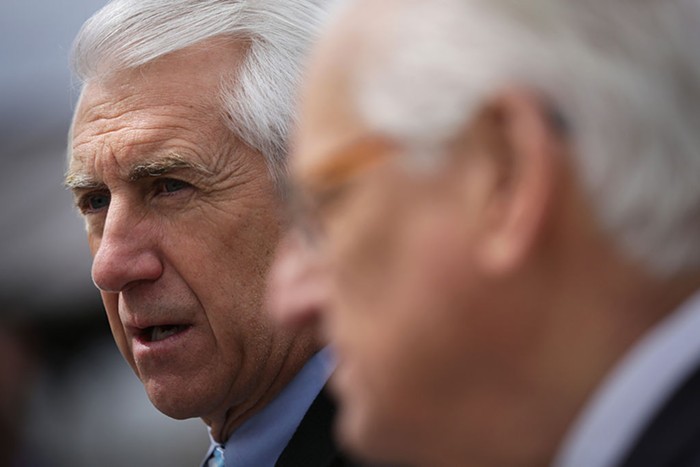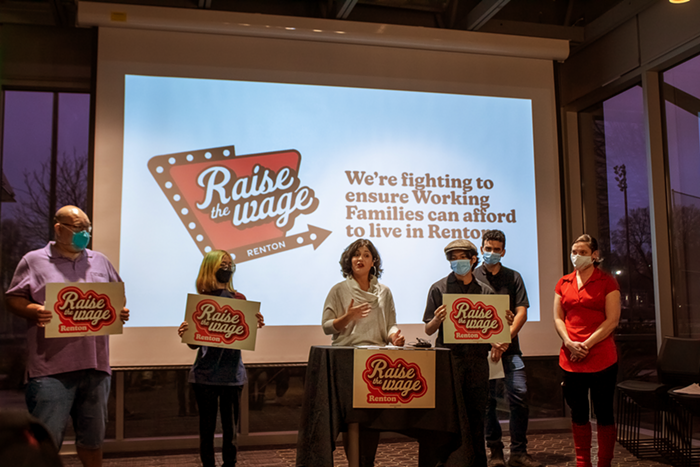As I walked down Seventh toward Pine, there was no sound on the streets except an echoic clanging of metal coming from the rising new wing of the Convention Center. The rhythm of this clanging was arresting. I looked up at the center's hulking mass and realized that, despite a general shutdown of every business in the downtown core, this thing was still alive and growing. Indeed, bursts of bright sparks cascaded from the top floors of the metal structure. This, I thought, is the real monster of the WTO debacle, and no one even noticed it. More astonishing yet was how the Convention Center seemed not to notice me, or the protestors (who had since scattered), or the cops, who raced back and forth in armored vehicles. The structure was preoccupied with one thing: growing and consuming more city space.
One reason why the Convention Center showed such brazen indifference to the riot and the damage it inflicted on our city could be because, ultimately, the structure made downtown what it is today -- a bustling consumer paradise. Without the Convention Center none of this prosperity would have occurred. As the legend goes, one day developer Jim Ellis (who is something of a local Robert Moses) was staring at the vacant Frederick & Nelson building, and decided that downtown was headed for doom unless he did something right away. So he walked across the street to Nordstrom and told the late James Nordstrom that if his store moved into the Frederick & Nelson building, he would expand the Convention Center. Nordstrom immediately accepted the offer (it being a "win-win" situation), and the rest is history: FAO Schwarz appeared, Niketown appeared, and Planet Hollywood appeared, fastening themselves to this "redevelopment anchor" which would "pump millions into the cash-hungry [city], filling hotels, restaurants, and shops." After the riots (the center's first big offering to the downtown core), these maimed mega-stores could only watch in stunned silence as the center's expansion boomed unabated amid billions of showering sparks.
The Event Business
The Convention Center's smug attitude was not unfounded: For the last 20 years, American cities have had nothing but blind faith in the importance of convention centers. For downtown developers and civic leaders, a convention center is the only way to boost a lagging city economy. Indeed, one would think this is all our urban planners learn in school, because they act as though there is no other way to bring a sleepy city back to life.
Conventioneering, or "the event business," generates about a $83 billion a year and caters primarily to well-heeled professionals who spend, on average, $1,000 per visit. There are about 87,000 conferences a year in America. Some are functional, like "Digestive Disease Week" and the "American Society for Reproductive Medicine," while others are "meta-meetings" (in both size and name), such as the "American Society of Association Executives" and "Worldwide Dream-Builders Association." Conventions come not only in different shapes and sizes and levels of abstraction, but also in different races. Black Americans, for instance, bring about $3 billion a year to the convention business -- in fact, some cities try to attract conventions by overemphasizing their blackness. (Kansas City claims "[Our] barbecue definitely draws the crowd"; St. Louis boasts "[We have] African Americans in high places"; Detroit stresses how "Aretha Franklin and Anita Baker cut their teeth here. Joe Louis learned his moves here. And the Motown Sound made musical history here.") And if this weren't enough, there is even a distinct class factor in conventioneering. Take the city of Detroit, which targets lower-end professionals. Instead of spending advertising dollars to attract physicians' conferences, it focuses on conventions for medical technicians. Seattle, on the other hand, wants only "high-end" conferences "whose delegates," it believes, "tend to come with expenses paid and bigger credit card limits."
Altogether, the event business is the most rarefied of all commercial enterprises; it is a meta-business, a business for businessmen who want to talk about their business. This line of work is not for the cautious (those who think in small, careful sums and try to make sense of an investment): not only does the event industry operate in a rarefied realm, but there's stiff competition here as well. (Tacoma is about to build a $50 million convention center, while Spokane has set aside $85 million for one of its own.) If you want to be a part of this business, you have to think big, speculating costs, expenses, and profit in fantastic and purely abstract terms. This is why the event business is often compared to the Cold War arms race ("[It is a] civic arms race," said the Seattle Times; "It's exactly like the international arms race!" said Ruth Messinger, a New York City councilwoman). You may remember the Cold War as the first purely abstract war in recorded history.
Seattle is now committed to joining in this impossible war. Our Convention Center is more than doubling its exhibition space, and by the year 2001 it will command five city blocks.
"[Seattle's] primary group is the national convention," says the Convention Center's friendly president/general manager, John Christison. "You see, a typical convention moves in rotation; they start in the east, move to the midwest the next year, and the west in the third. So we are not competing with, say, Boston; our competition is with western cities like Phoenix, San Diego, and to a lesser extent Salt Lake City and Portland. Currently we are the smallest of the 51 convention centers in the market, but our expansion will double our current space to 210,000 square feet. But that's still not much -- the convention center in Chicago, the McCormick, has 2.7 million square feet of exhibition space! San Diego currently has 255,000 [square feet] and is in construction to double it."
"Do you think the WTO will affect the growth of the Convention Center?" I ask.
"Not at all. We are still moving forward. The construction was delayed a little bit. But we did not instruct construction to stop during the disturbance, so they continued."
The End of the City
It is said that at the current rate of growth of New York City's Javits Center -- which is competing with Chicago's orotund McCormick -- Manhattan will be enclosed by its own exhibition hall by the year 2035. If our Convention Center continues to grow at its present rate, it will completely cover downtown Seattle by the year 2015. Imagine that -- in our near future, as our transport shuttle descends through the clouds, preparing to land on what may then be called the Boeing Spacestrip, we will see a big, windowless bubble where many years ago downtown Seattle once stood. On this bubble's fringe heavy construction will continue -- the sparks and cranes of uninterrupted growth.



















